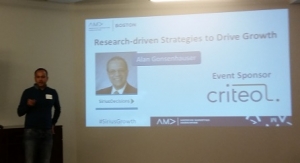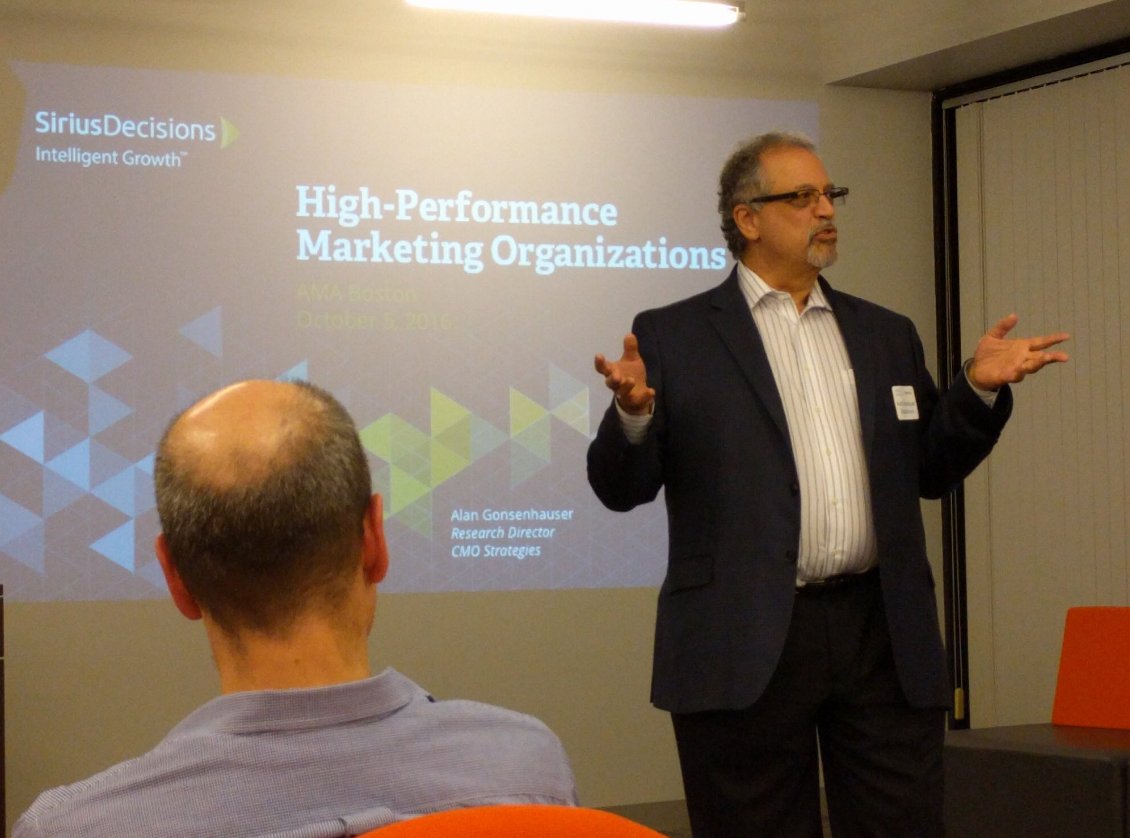A large and appreciative audience of AMA Boston members and guests gained invaluable advice on how to help their companies grow in our increasingly complex marketing environment. The event was held on Wednesday, October 5th, 2016 at the beautiful facility of Criteo, a global leader in digital performance marketing, on State Street.
 The evening started with lively networking amidst an open bar and delicious hors
The evening started with lively networking amidst an open bar and delicious hors  d’oeuvres. AMA Boston President Nirmal Parikh welcomed the large group, congratulated chapter “Volunteer of the Quarter” Robert Beadle, thanked Criteo, and asked Mary-Katherine McCarey, VP of Programming, to introduce Alan. The event accelerated into a fast-paced presentation focused on the transformation of marketing and how
d’oeuvres. AMA Boston President Nirmal Parikh welcomed the large group, congratulated chapter “Volunteer of the Quarter” Robert Beadle, thanked Criteo, and asked Mary-Katherine McCarey, VP of Programming, to introduce Alan. The event accelerated into a fast-paced presentation focused on the transformation of marketing and how  we can create high-performance teams. Drawing on decades of experience, first in finance and more substantially as a CMO and advisor to CMOs, Alan weaved in Sirius analysis along with real-life experience. The key take-aways are below, starting with the Cliff Notes version for our super busy readers:
we can create high-performance teams. Drawing on decades of experience, first in finance and more substantially as a CMO and advisor to CMOs, Alan weaved in Sirius analysis along with real-life experience. The key take-aways are below, starting with the Cliff Notes version for our super busy readers:
Evening Summary:
- Marketing is undergoing disruption
- It’s all about the customer- personas, needs, journey; measuring satisfaction is critical
- Cross-functional alignment can deliver significant benefits for key growth metrics: revenue and profits
- Alignment between revenue-producing units, e.g. marketing and sales, is critical for high-performance teams.
- Campaigns are often misunderstood or poorly defined; the key is to pivot from a product to customer focus
Detailed Notes:
- Marketing, especially B2B, is increasingly complex due to the birth and evolution of the web, inbound/content marketing, technology and data capabilities, agile strategies, customer-centric approaches, and a focus on KPIs vs. mere activity. Marketing has moved far beyond a cost center that just produces brochures!
Other key transformations include targeting niches and creating personas, emphasizing the quality and not quantity of leads, understanding the buyer journey, and the need for alignment among a company’s three sources of revenue – marketing, sales, and product.
- 40 – 70% of content creation funds are wasted, and users often can’t find needed content in crunch time.
- “It’s helpful for marketers to have field experience”
- “The relationship between the CFO and the CMO is key”
- “Marketers must look at margin not revenue for comparison with cost” – need for credibility with finance.
 High-performance teams play a major role in success, and are notable for these characteristics: a strategic outlook, use of KPIs, respect for process, the use of insight (e.g. combining analytics with big data), key team alignment, a culture of experimentation coupled with competence, and agility.
High-performance teams play a major role in success, and are notable for these characteristics: a strategic outlook, use of KPIs, respect for process, the use of insight (e.g. combining analytics with big data), key team alignment, a culture of experimentation coupled with competence, and agility.- There are two types of innovation that most high-performance teams leverage: sustainable and disruptive; top companies learn how to disrupt themselves vs. being disrupted, or they wind up like Kodak or DEC.
- The “Road to High-Performance Marketing” is based on organization; the audience framework (“understand their watering holes”); targeting, personas and the customer journey; auditing your content to ensure you have what customers need; planning; alignment between sales and marketing, as well as aligning marketing strategy with the business goals.
- Alignment can be measured. In Sirius’s survey of over 400 companies, these were the four factors of a company’s growth:
- Market – industry growth
- Competitiveness – pricing, position
- Efficiency- profitability
- Alignment
While market growth is the biggest reason for a company’s results, alignment is significant and the third most important factor.
- How do you get to alignment? Interlocking processes; measurement systems; processes and organization; “waterfall performance:” pipeline impact
- Planning is critical: one key is to agree on what marketing can do and not do, to ensure it does not become a “dumping ground.”
- The “Campaign Framework” explains what comprises a campaign, as it leads a pivoting from product- to customer-centricity. Effective campaigns are based on: buyer needs (theme); roll-up of four program families (see below); five core jobs; runtime of at least 12 months; aligns marketing with other teams and within the discipline; and contributes to all phases of a buyer’s need
- The four Program Families are:
- Brand reputation
- Demand creation
- Sales enablement
- Market Intelligence
The program concluded with a lively and lengthy Q+A session. While Alan encouraged and fielded questions throughout the session, this extended period prompted many audience members to raise additional topics, which the speaker handled with patience and enthusiasm. The Twitterverse was active too – check out the points made by attendees using #siriusgrowth!
 AMA Boston would like to thank Alan Gonsenhauser, Criteo, and our engaged audience for a great evening! There are too many upcoming events and webinars upcoming to mention – see them all on our Events page. We look forward to see you soon.
AMA Boston would like to thank Alan Gonsenhauser, Criteo, and our engaged audience for a great evening! There are too many upcoming events and webinars upcoming to mention – see them all on our Events page. We look forward to see you soon.


